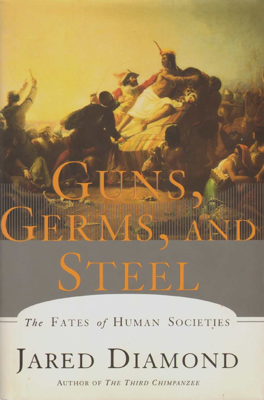Summary
Key Concepts and Theories
Jared Diamond's Guns, Germs, and Steel: The Fates of Human Societies offers a sweeping explanation for the varying rates of development among different human societies. Central to Diamond's thesis is the idea that geographical and environmental factors primarily shaped disparities in human development rather than inherent differences in individual or cultural capabilities.
Environmental Determinism
Early human societies' success largely depended on their ability to domesticate plants and animals, which was significantly influenced by their geographic location. For instance, Eurasia, with a plethora of domesticable plants and large mammals, saw the rapid spread and development of agricultural societies. This contrasted starkly with areas like the Americas or Australia, where fewer suitable domestication candidates led to slower societal advancement.
Technological Disparities
Technological and military advancements were also crucial in shaping historical trajectories. Societies with access to more sophisticated technologies, due to earlier food production capabilities, could develop better tools, more effective governance structures, and stronger armies. This technological edge was evident during European colonization, where superior weapons and organized military strategies allowed Europeans to dominate many technologically less advanced native populations.
Impact of Diseases
The spread of diseases played a critical role in the conquests by Europeans. Native populations in the Americas were decimated by Old World diseases such as smallpox, to which they had no immunity. This biological factor, often overlooked, was pivotal in the Europeans' ability to conquer more populous and sometimes more sophisticated civilizations.
Agricultural Success and Societal Complexity
Diamond also emphasizes the role of agriculture in societal development. The ability to produce surplus food led to higher population densities, more complex institutional governance, and social stratification. These complex societies had the resources to support craftsmen, soldiers, and bureaucrats, who in turn fostered technological innovation and state formation.
Geographic and Biological Influences
The orientation of the continents themselves influenced the rate of spread of agriculture, technology, and ideas. Eurasia's primarily east-west axis facilitated these spreads due to the consistency in climate and daylight hours across latitudes, unlike the Americas and Africa, which have a north-south orientation that presents more varied climatic and ecological zones.
Conclusion
Guns, Germs, and Steel asserts that the fates of human societies have been largely determined by geographical and environmental factors that dictated food production capabilities and the consequential technological and political developments. Diamond argues effectively against racial theories of global history, instead proposing that some societies developed more rapidly due to geographical luck in the distribution of potentially domesticable plants and animals. This groundbreaking perspective challenges the way we understand cultural and racial histories, emphasizing the power of environment over ingenuity in shaping the destinies of human societies.
Per-chapter summary
- UP TO THE STARTING LINE: What Happened on All the Continents Before 11,000 B.C.?
- A NATURAL EXPERIMENT OF HISTORY: How Geography Molded Societies on Polynesian Islands
- COLLISION AT CAJAMARCA: Why the Inca Emperor Atahuallpa Did Not Capture King Charles I of Spain
- FARMER POWER: The Roots of Guns, Germs, and Steel
- HISTORY’S HAVES AND HAVE-NOTS: Geographic Differences in the Onset of Food Production
- To FARM OR NOT TO FARM: Causes of the Spread of Food Production
- HOW TO MAKE AN ALMOND: The Unconscious Development of Ancient Crops
- APPLES OR INDIANS: Why Did Peoples of Some Regions Fail to Domesticate Plants?
- ZEBRAS, UNHAPPY MARRIAGES, AND THE ANNA KARENINA PRINCIPLE: Why Were Most Big Wild Mammal Species Never Domesticated?
- SPACIOUS SKIES AND TILTED AXES: Why Did Food Production Spread at Different Rates on Different Continents?
- LETHAL GIFT OF LIVESTOCK: The Evolution of Germs
- BLUEPRINTS AND BORROWED LETTERS: The Evolution of Writing
- NECESSITY’S MOTHER: The Evolution of Technology
- FROM EGALITARIANISM TO KLEPTOCRACY: The Evolution of Government and Religion
- YALI’S PEOPLE: The Histories of Australia and New Guinea
- HOW CHINA BECAME CHINESE: The History of East Asia
- SPEEDBOAT TO POLYNESIA: The History of the Austronesian Expansion
- HEMISPHERES COLLIDING: The Histories of Eurasia and the Americas Compared
- HOW AFRICA BECAME BLACK: The History of Africa
